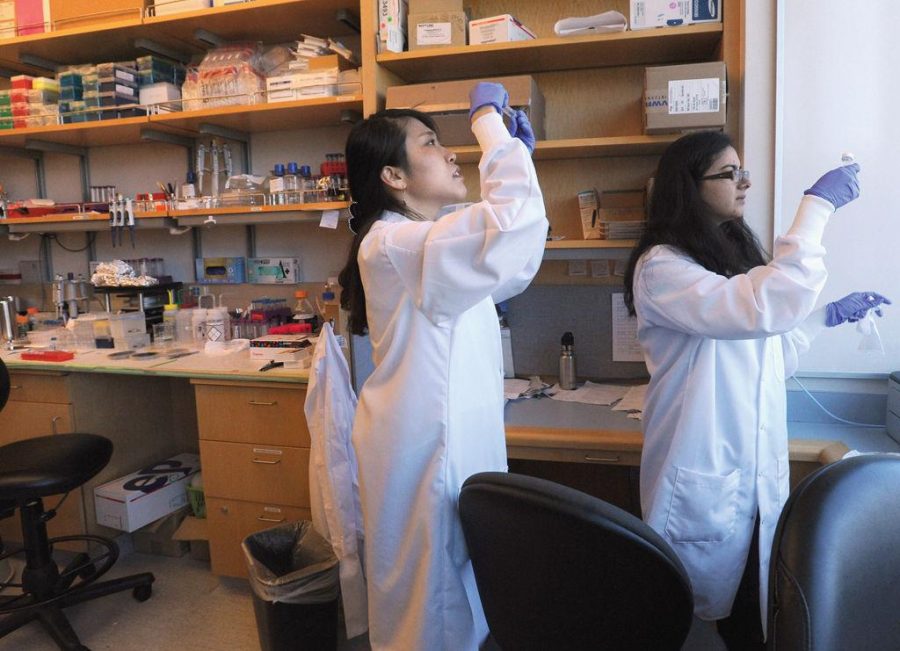Pitt working to attract female engineering doctoral students
October 28, 2014
After the American Society for Engineering Education (ASEE) determined Pitt’s Swanson School of Engineering to be the U.S. university with the highest percentage of doctoral degrees awarded to women in engineering from 2010 to 2011, the school has dropped below the top 20 in the last two years.
Gerald Holder, U.S. Steel Dean of Engineering at Swanson, said this year the school dropped to less than 30 percent of doctoral degrees awarded to women because so many women who graduated in the previous few years haven’t been replaced by new female students.
“We hope to get the numbers back up, but with the Ph.D. studies lasting four to six years, there is a long incubation period before degrees are awarded,” Holder said. “The fact that we had [that statistic for] three years in a row meant that it wasn’t a fluke. It’s definitely a characteristic of the institution.”
Swanson awards roughly 60 Ph.D.s per year, Holder said, and last year they awarded a record high of 72. According to Holder the Ph.D. enrollment has been steadily rising — in the past 15 years, it has increased from 180 to 440 students.
Sanjeev Shroff, chair of the Department of Bioengineering at Swanson, said the bioengineering discipline is often a popular draw for women seeking engineering degrees primarily because of the wide-ranging opportunities in academia, industry and public policy that exist after finishing the degree.
“The biggest attraction for Pitt’s bioengineering doctoral program is UPMC, the medical enterprise,” Shroff said.
Shroff said when the bioengineering department interviews candidates for the graduate program, they pay particular attention to recruiting women and racial minorities.
“We make sure that the infrastructure exists for them to succeed,” Shroff said.
There are multiple groups on campus that provide a support structure for women engineers such as the Graduate Women in Engineering Network (GWEN), created by engineering professors in the spring of 2014, and the Society of Women Engineers (SWE). Sixty-five female engineers in New Jersey formed SWE in 1950, and the Pittsburgh section became the first one chartered in 1951, according to the group’s website.
Shroff added that the majority of incentive to pursue bioengineering is provided by the discipline itself — it is not specific to Pitt bioengineering.
“Bioengineering is particularly attractive because you are working with human beings and that is a big attraction, in my view, for women … working with people as opposed to working in a room with computers,” Shroff said.
Chelsea Stowell, a second-year doctoral student in bioengineering, said being a woman in engineering can be challenging because you have to be comfortable with working in a predominantly male field.
“When you are in a big group of guys, the conversation, the feel, everything is different than if you were in a big group of girls,” Stowell said. “Depending on your personality and what you are used to, it can be more of a transition for some people than others.”
Stowell said one of the biggest advantages she had as an undergraduate student was the opportunity to work closely with highly successful and well-respected female professors and graduate students in the engineering program.
“I benefitted a lot from having a lot of other women around to inspire and [be a] role model,” Stowell said.
For Nicole Ostrowski, a fifth-year doctoral student in biomedical engineering, joining student organizations was beneficial in terms of providing a support structure and networking.
As an undergraduate female engineering student, Ostrowski became involved in engineering organizations. She was part of Phi Sigma Rho, an engineering sorority, as well as Engineers Without Borders, a national service organization that works on engineering projects to help improve impoverished or devastated areas.
“I think it’s because it sort of speaks to what women like to do,” Ostrowski said. “We like to help people, make a difference. It’s not just about the money.”
As a doctoral student, Ostrowski is still involved with Engineers Without Borders and also joined Women in Bio, a citywide networking organization for women in the biotechnology field.
Stowell said the mentorship opportunities offered through GWEN are very valuable.
“Your success in a career is often dependent on having a mentor that can guide you and give you advice,” Stowell said. “While some women can do well with male mentors, it can be discouraging sometimes to have all your mentors be male all the time. There are just some things women encounter that men don’t because we are in different situations in life.”
Jenny Orie, a freshman engineering student, said there are more men than women in her classes, but it doesn’t intimidate her or deter her from wanting to be an engineer.
The classroom is just one aspect of engineering, she said, and it doesn’t bother her because there are other factors to college, such as clubs and residence halls that aren’t male dominated.
Holder said all engineering faculty members are sensitive to diversity issues, and they only hope to improve further.
“Our reputation as a school of engineering has improved dramatically over the last 10 years, and that’s been helpful for attracting a wider spectrum of people,” Holder said.



